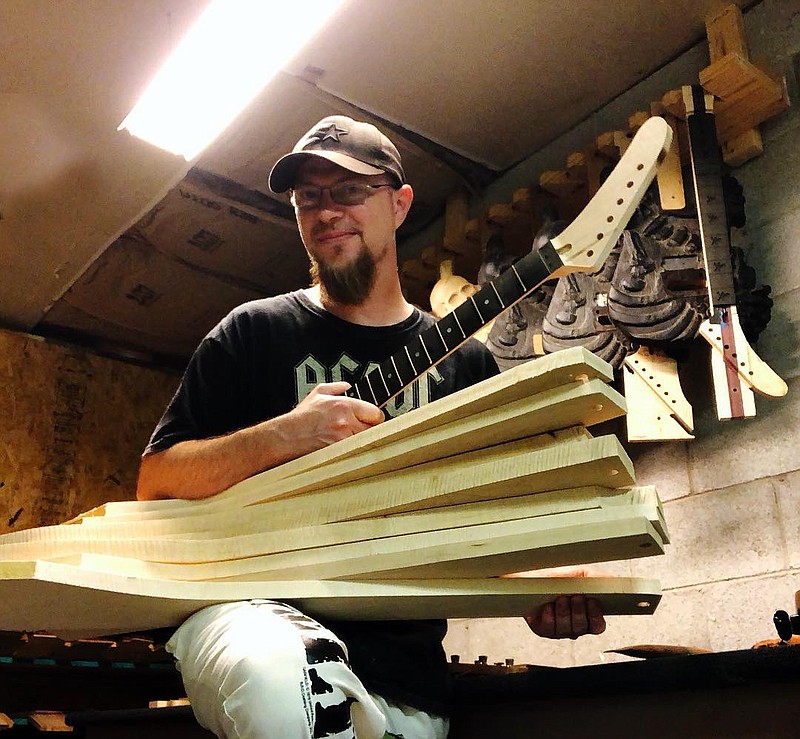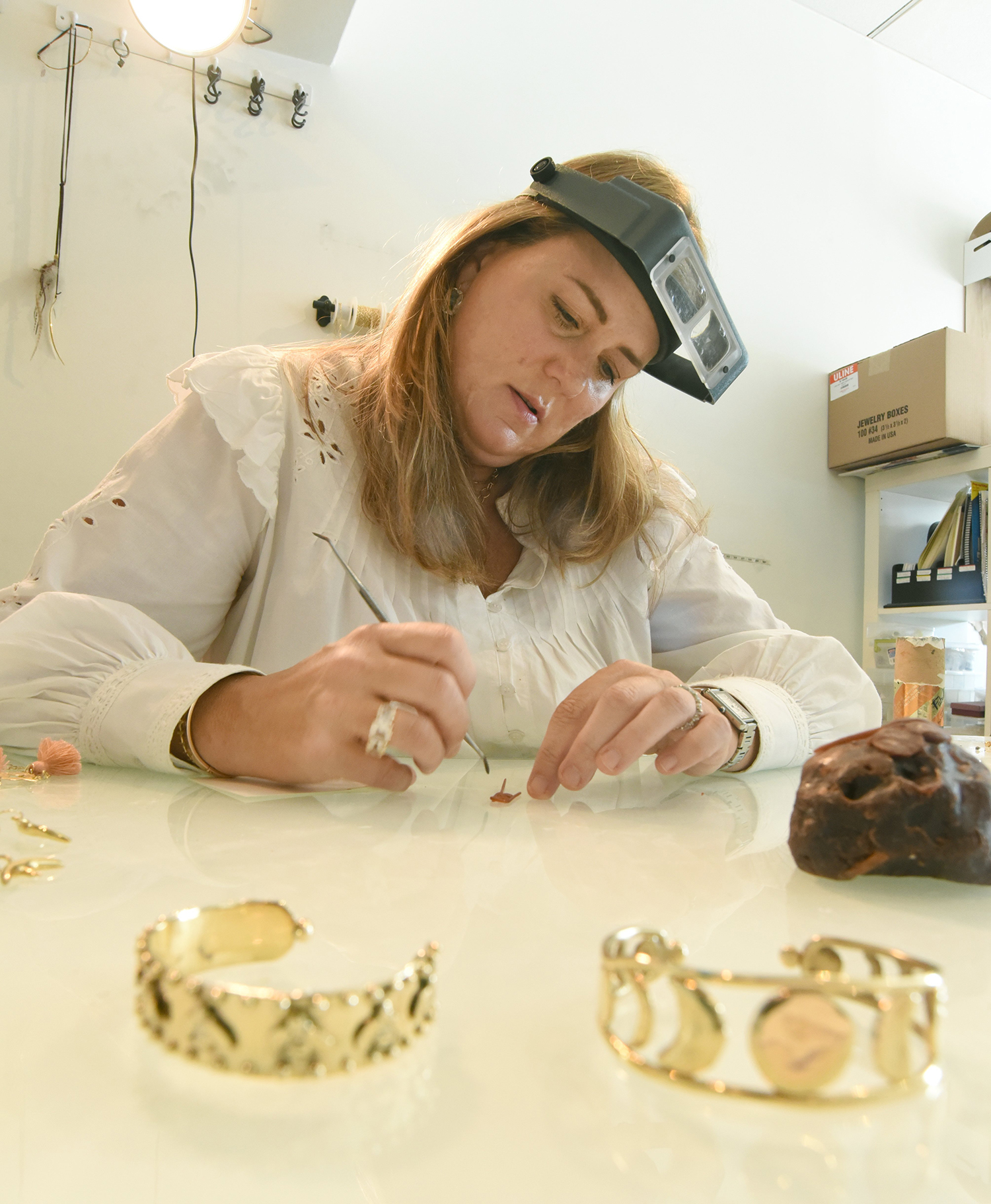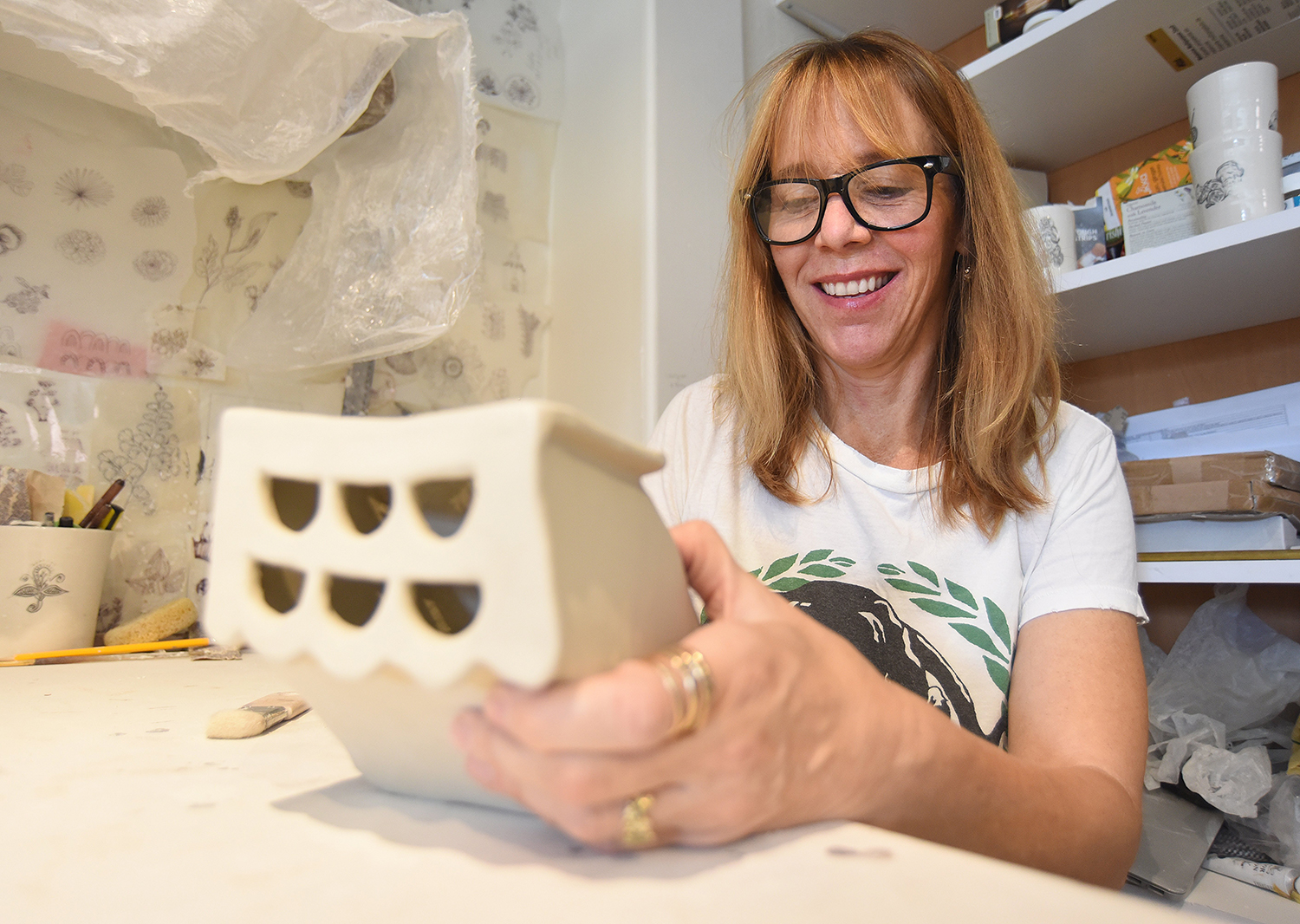Any Sunday trip to the Chattanooga Market will tell you that the Scenic City is filled with talented creatives. But what does it take to go from merely a maker to a household name for clients across the country? We asked three local artisans who are not only keeping the handmade nature of their craft alive, but finding success well beyond their hometown.
*****
Louisa Hurst
Makes: Louisa Guild Jewelry
Notable clients: Actress Tiffani Thiessen; online retailer One Kings Lane
Louisa Hurst grew up in the kind of family that saw fallen trees in the backyard as opportunities to create Christmas gifts. Her father and mother both dabbled in whatever creative process grabbed them, and passed that streak onto their three children.
When Hurst's younger brother was killed in a car accident shortly after his high school graduation, her mother turned to sculpting. The family was dedicating the new dormitory they'd built in his honor at St. Andrew's-Sewanee School, his alma mater, and wanted him to live on in the space.
Hurst's own creativity was a little more corralled. Whether working as an interior designer for Promise Hotels and, later, Chattanooga homeowners, or as a systems furniture dealer for Nike, she was constrained by her clients' preferences. And she liked it that way - at least that's what she thought.
Her jewelry-making started organically. She wanted a bee necklace, so she picked up her mother's tools and made one.
Beyond the symbolism of the bee itself, the medium struck a chord. Every Christmas, her grandmother, Virginia Guild, would gift pieces from her personal jewelry collection.
"It was not just a bee on a necklace. Bees are a wonderful symbol of perseverance," Hurst says of her first creation, which has taken on even more symbolism as she's spent the past eight years building her business. "Their little wings aren't really ergonomically supposed to hold their body up in flight, but nobody told them they couldn't do it. And then they pollinate the world. It just felt so deep and so meaningful.
"Jewelry is such a sentimental gesture for somebody. I hope my jewelry speaks to who people are at their core."
What was your (first) big break?
My first big break involved going to New York to do my first show. I was featured in a few TV shows, like "White Collar." The main woman (Tiffani Thiessen) wore my stuff for years. But mostly I just started to slowly gain stores throughout the country. Some of the stores were huge goals for me, like One Kings Lane, Kuhl Linscomb in Houston, and Blackberry Farm (in Walland, Tennessee). But my greatest supporters come from my own hometown. My partnership with Sophie's (Shoppe) has been a huge success and it has given me the roadmap to try to emulate in every other retail relationship that I have.
What does that roadmap look like?
Back in the beginning, there was a whole process of [the store owners] picking stuff out and really combing through my things. It came to a point where they knew my products, knew the quality and knew they loved it. That just opened the door and has given me freedom where I don't feel confined to a line sheet. I'm looking for stores that are really invested in me and trust me as an artist to know what works.
What did people say when you told them of your plans to start this business?
My friends and family have always been such wonderful supporters of me. I do think they generally liked it, I don't think they would've bought it if they didn't, but it started like that: "I want one of those." And then it was, "Let's try to figure out a way to not have [a] day job." A lot of that was just having children and wanting to be at home with them, but then also really finding just this satisfaction in what I was doing and not wanting to give that up. I remember thinking at the time, "I don't have to move the bow here; I don't have to change the pillows. I don't have to compromise what I'm thinking."
What's the best piece of advice you received?
That I needed to make retail money and wholesale money to keep my business going and to get my name out in the world. Charging retail is more profit to you as the artist, and again, you're unbound by what's popular. You need to be able to have that freedom in the beginning when you don't have all those great relationships. It's so hard to keep that because you want relationships with stores; you need that to get your name out. It's a balance. I think we all kind of get it now: There's going to be an online presence (retail) and there's going to be a store presence (wholesale), and there's a respect there.
What keeps you in it?
Any time I get even the slightest sale, to me that's just a huge compliment, and I never want to lose that feeling. And honestly, it's Chattanooga that gives me that because I see it more. I hope my jewelry is an outward expression of a deeper truth. I love connecting with people on that deeper level.
>> To see more of Hurst's work, visit louisa-guild.myshopify.com.
*****
Christopher Woods
Makes: Guitars
Notable clients: Motley Crue's Vince Neil; George Lynch of Dokken, Lynch Mob, KXM
Christopher Woods will always remember the day Eddie Van Halen died. He reigned over the rock era that inspired Woods to not just make music, but also the instruments. A bassist in a high school band in the mid-'80s, Woods lusted after the guitars he saw onstage.
"I became a teenager in 1984. Rock music was at its peak during this time and I wanted into the party," Woods says. " The guitar heroes always had instruments that you couldn't buy off the shelf. The only way to get them back then was to build your own."
He built his first guitar in woodshop class, learning as he went. "My woodshop teacher told me, 'You can use the tools, but I have no idea how to help you plan it out.'"
After graduating, Woods attended the Roberto-Venn School of Luthiery in Phoenix, and then landed a job with revered luthier Michael Tobias in California before Gibson bought and moved the operation.
Coming full circle, Woods created a guitar played by '80s rocker Vince Neil on the final Motley Crue tour in 2014. But while the legends of his era may be fading out, Woods' work is still going strong. "Business has gone through the roof during the pandemic and lockdowns," he says.
What was your (first) big break?
I don't know if I can say there ever was a big break, just a lot of encouraging and exciting moments along the way. Most of those came because I asked for the opportunity or know people who know people. I think the bottom line is that you have to do your best work every time, or at least strive for it, be creative and think outside the usual boxes. These days, there are plenty of ways to reach a worldwide audience.
Has your enterprise evolved in any way?
There was no internet when I started! You can look up how to do anything on YouTube and there are tons of videos on how to make a guitar. I started out mainly making guitar bodies. After I got good at that, I started making guitar necks, then full guitars, then I started expanding my options to include custom inlay, LEDs, 3-D carvings on the bodies, custom paint, etc. Recently I made a setup to offer roasted maple necks that I do in-house. I am also building my own CNC machine. There is always something new to tackle.
What did people say when you told them of your plans to start this business?
In the early days when I was starting out, people didn't know what to think of it. I remember comments like, "Oh, I thought a luthiery school was some kind of religion" (guidance counselor), and "I've never actually thought about someone building guitars as a job" (most people in the '80s and '90s).
What is your favorite part of making guitars?
Freedom, creativity, that feeling you get when you come up with an idea that you know is going to blow people away when they see it - those are the kinds of things that will keep you working 16 hours a day until it is done. Although, it is also pretty exciting to see something you built out there on an arena rock tour in front of millions of people. Also, when you create something completely original and unique that sparks interest to a large audience, that is awesome. A bass guitar I built a couple of years ago got picked up by several guitar fan pages on social media and I stopped counting the "likes" and comments after about 20,000 or so. That was super-cool!
But this is a job and I don't get to do that kind of thing every time. But even when it feels like "just another job" it's still a day where I got to build a guitar, and that's a pretty cool way to make a living.
What's next?
People tend to want replicas of famous '80s guitars, and I understand that because it is what got me interested in the first place. But I am working toward some original designs that stand on their own without being attached to a celebrity player.
>> To see more of Woods' work, visit christopherwoodsguitar.com/home/index.html.
*****
Hope Bailey
Makes: Hope + Mary ceramic dishes and lamps
Notable clients: Gump's in San Francisco and other national retailers
Whoever said 'Those who can't do, teach' never met Hope Bailey. A former K-12 art teacher in Chattanooga, Chicago and Augusta, Georgia, she decided to leave the classroom behind for the showroom. And her pieces are now shown in retail shops from coast to coast.
"I had spent the last year teaching myself a new Korean ceramic technique called mishima," she says of her 2013 decision to pursue ceramics full time. "This technique allowed me to combine my love for drawing and painting with the ceramic process. I had a vision of what I wanted to create and make based on what I wanted to use in my home. So when it came time to renew my [teaching] contract, I declined and decided to follow my intuition."
She fell in love with both mediums in her mid-20s, while a student at the University of Colorado-Boulder. She already had a degree in anthropology, but went back to get certified to teach art.
"I loved painting because it is more cerebral. It allows me to work through thoughts, emotions," Bailey says. "Also, painting is two-dimensional and allows me to problem solve how to visually represent what I see in my mind. Ceramics is more grounding, much more tactile. It feels more automatic, straightforward, of the moment."
What is your favorite part of making ceramics?
The practice of making ceramics requires mental presence; I have to be focused and present in the moment while I am making ceramics. It keeps me centered and grounded through the details and concentration required during the process of creating. Being a production ceramicist can be frustrating at times. Things break during the making process; kiln firings fail. There are all kinds of pitfalls present when making ceramics. It makes you confront the impermanence of material things on a regular basis.
What did people say when you told them of your plans to start this business?
One day, while I was driving with my now-husband in the car, I told him I thought I wanted to quit teaching and start making ceramics full time. He asked me if I had a plan, a business plan, etc. I said no but I just knew it was what I wanted to do.
What was your (first) big break?
I found my way with a lot of help and advice from fellow business owners and makers. I worked hard in the studio to develop a line of work, and at the same time learned all the parts of building a business - making a website, paperwork, photography, furniture for booth displays, etc. After I launched my website, I began to show at craft shows: Renegade Craft Fair, One of a Kind, American Craft Council. In 2014 I started attending wholesale shows in New York where I started to build up a list of wholesale clients from around the country. Since then I have continued to grow my business, working with wholesale clients as well as continuing to grow my online presence. Attending wholesale shows in New York twice a year introduced me to other amazing makers who sold their products at the show, as well as so many incredible buyers who have supported my business for the last six years.
Did anything about the business side surprise you? What keeps you in it?
I have never worked harder than I have in the last six years. It has required constant focus and determination. There have been many hard moments, lots of long days and late nights. But I really love what I do. Even on the hardest days, I find joy in the process of making. I also get a great deal of pleasure from seeing other people react to my work and the joy it brings them. I love seeing any work in use, in someone's home. It is incredibly rewarding as a maker.
My work is meant to be useful while bringing beauty and joy.
>> To see more of Bailey's work, visit hopeandmary.com.


